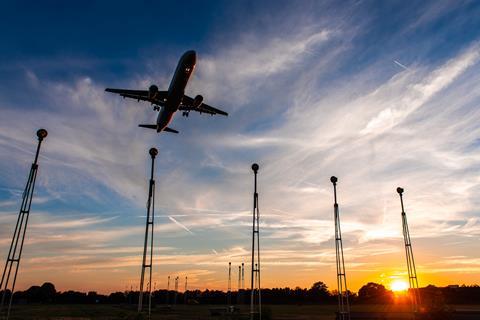With aviation just 26 years away from its self-imposed deadline of reaching net-carbon-neutrality, the notoriously slow-moving sector is now taking bolder, more concrete steps to develop technologies and lobby for regulatory change.
Todd Spierling, director of electrification for Collins Aerospace, says there has been a notable shift in the pace of progress toward this goal in recent years.
“My position did not exist two years ago, we did not talk about electrification with the enthusiasm we do today,” he said during a panel discussion on the state of the sustainability ecosystem at the ILA Berlin trade show on 6 June.
“You are now seeing not only papers and lab work, you are seeing real demonstrator aircraft built,” he adds. “And you didn’t see that a few years ago.”

It is not only the large, established cash-flush corporations that are broadly investing in sustainability. Many start-up companies with solutions for specific problems are also gaining traction.
“Start-up founders are notoriously optimistic,” says Arno Zimmermann, co-founder and chief technology officer at Spark e-fuels, a maker of hydrogen-based synthetic fuel. “We need to reinvent the whole industry, and it can’t be done overnight.” But, he adds, the industry is progressing in a positive direction.
He says that e-fuels, for example, can reduce the amount of direct CO2 emissions by 90-95%, as well as indirect CO2 emissions. That’s compared to 60-80% emissions reduction for regular sustainable aviation fuel (SAF) made from biomass. That said, the cost of developing these technologies is still a limiting factor.
While governments have in some cases stepped in to bankroll research, that is not true across the board. For example, in Germany, the federal government recently axed subsidies that would have supported the research and development spending of smaller firms like Spark, he adds.
“We would urge the ministry of transport to return this funding – we need to get it back online,” he says. “That’s the only way we can drive this technology forward and bring down the cost.”
NO SILVER BULLET
There is no “silver bullet” to solving the industry’s sustainability challenge, adds Roland Gerhards, chief executive of ZAL Centre of Applied Aeronautical Research, and there is a lot of scope for work on parallel paths across the wide spectrum of the industry.
“There is not a single solution [to reducing emissions] and that’s why we are having such exciting times in engineering,” he says. “We see a lot of parallel technology paths, and we need many solutions at the same time. It’s a huge challenge but it’s really exciting for young engineers.”
There are additional levers that can be pulled, quick wins for an industry that usually calculates in decades rather than months or years. Increasing fuel taxes, transforming air traffic regulations, implementing shorter routings and different descent profiles, optimising operations including, for example, single-engine taxiing are just a few that would contribute to decarbonisation a bit more quickly.
For their part, e-fuels have sometimes been criticised for requiring hydrogen to go through an additional step of production – the addition of CO2 extracted from the air – in order to create synthetic SAF. But e-fuels are more efficient in use as more of the stored energy can be extracted from the fuel than from hydrogen alone.
“There is room for hydrogen in the industry,” says Zimmermann. “But it is the sustainable fuels that will be really making a difference between now and 2050.”
Gerhards agrees. “The laws of physics will not change, you can’t fight that. Hydrogen is maybe the next step, but not for longer-range operations.”
Collins’ Spierling says that the research being conducted today will not be ready for commercial aviation prime-time for decades yet. But engineers are learning valuable lessons for the future.
“You are seeing in the smaller aircraft – the drones, the UAMs, regional air mobility, urban air mobility – these are the building blocks, and there’s an opportunity there to get those technologies into service and help set the stage” for these types of solutions on larger aircraft, he says.
Regulations and policies have also been a sticking point, and new frameworks will be needed to before the technologies can become mainstream.
“We will need to identify things that can save the airlines and consumers money,” he adds. “That’s where you will see that immediate change.”


























